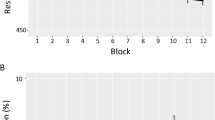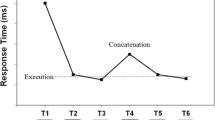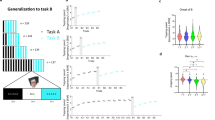Abstract
We investigated under which conditions sequence learning in a serial reaction time task can be based on perceptual learning. A replication of the study of Mayr (1996) confirmed perceptual and motor learning when sequences were learned concurrently. However, between-participants manipulations of the motor and perceptual sequences only supported motor learning in cases of more complex deterministic and probabilistic sequence structures. Perceptual learning using a between-participants design could only be established with a simple deterministic sequence structure. The results seem to imply that perceptual learning can be facilitated by a concurrently learned motor sequence. Possibly, concurrent learning releases necessary attentional resources or induces a structured learning condition under which perceptual learning can take place. Alternatively, the underlying mechanism may rely on binding between the perceptual and motor sequences.







Similar content being viewed by others
Notes
Although Experiments 2–4 show no trend toward perceptual learning, it could be remarked that more statistical power in these experiments is required in order to accept an absence of perceptual learning. Therefore, to determine whether perceptual learning effects would come about when statistical power was increased, we conducted a repeated measures ANOVA on the combined data of the perceptual conditions of all three Experiments 2–4, with sequence structure (32, 12 or probabilistic in Experiments 2, 3, and 4 respectively) as between-participants factor and block as within-participants factor. With a total sample size of 48 participants, neither the main effect of sequence structure nor the interaction between block and sequence proved to be significant respectively F(2,45) = .95, p = .40 and F(18,405) = .81, p = .70. This allowed us to further analyze perceptual learning in the form of an increase in RT in the random Block 9 compared with the surrounding structured Blocks 8 and 10. Even across 48 participants, planned comparisons revealed that perceptual learning did not emerge, F(1,45) = 1.48, p = .23. Hence, the combined analysis of the data of Experiments 2–4 shows that perceptual learning is still absent when the statistical power is increased. Nevertheless, we were always able to assess clear motor learning effects in Experiments 2–4, although the samples used to assess motor and perceptual learning were always comparable. This indicates that a lack of statistical power probably cannot explain the absence of perceptual learning in Experiments 2–4. Even if it is assumed that perceptual learning in Experiments 2–4 was indeed present, but that the effect was so small that it required more statistical power (than motor learning) to be detected, the difference between the motor and perceptual condition remains. Hence, it can only be concluded that sequence learning primarily relies on motor learning and that this type of learning is much more dominant than perceptual learning.
We would like to thank the reviewers for these suggestions.
References
Bischoff-Grethe, A., Goedert, K. M., Willingham, D. B., & Grafton, S. T. (2004). Neural substrates of response-based sequence learning using fMRI. Journal of Cognitive Neuroscience, 16, 127–138.
Cleeremans, A., & McClelland, J. L. (1991). Learning the structure of event sequences. Journal of Experimental Psychology: General, 120, 235–253.
Cock, J. J., Berry, D. C., & Buchner, A. (2002). Negative priming and sequence learning. European Journal of Cognitive Psychology, 14, 24–48.
Cohen, A., Ivry, R. I., & Keele, S. W. (1990). Attention and structure in sequence learning. Journal of Experimental Psychology: Learning, Memory and Cognition, 16, 17–30.
Frensch, P. A., & Miner, C. (1994). Effects of presentation rate and individual differences in short-term memory capacity on an indirect measure of serial learning. Memory & Cognition, 22, 95–110.
Frensch, P. A., Buchner, A., & Lin, J. (1994). Implicit learning of unique and ambiguous serial transitions in the presence and absence of a distractor task. Journal of Experimental Psychology: Learning, Memory and Cognition, 20, 567–584.
Frensch, P. A., Lin, J., & Buchner, A. (1998). Learning versus behavioral expression of the learned: The effects of a secondary tone-counting task on implicit learning in the serial reaction time task. Psychological Research, 61, 83–98.
Goschke, T. (1998). Implicit learning of perceptual and motor sequences: Evidence for independent learning systems. In M. A. Stadler & P. A. Frensch (Eds.). Handbook of implicit learning (pp. 401–444). Thousand Oaks, CA: Sage.
Grafton, S. T., Hazeltine, E., & Ivry, R. (1995). Functional anatomy of sequence learning in normal humans. Journal of Cognitive Neuroscience, 7, 497–510.
Heuer, H., Schmidtke, V., & Kleinsorge, T. (2001). Implicit learning of sequences of tasks. Journal of Experimental Psychology: Learning, Memory and Cognition, 27, 967–983.
Hommel, B. (1998). Event files: Evidence for automatic integration of stimulus-response episodes. Visual Cognition, 5, 183–216.
Howard, J. H., Mutter, S. A., & Howard D. V. (1992). Serial pattern learning by event observation. Journal of Experimental Psychology: Learning, Memory and Cognition, 18, 1029–1039.
Keele, S. W., Jennings, P., Jones, S., Caulton, D., & Cohen, A. (1995). On the modularity of sequence representation. Journal of Motor Behavior, 27, 17–30.
Kelly, S. W., & Burton, M. A. (2001). Learning complex sequences: No role for observation? Psychological Research, 65, 15–23.
Koch, I. (2001). Automatic and intentional activation of task sets. Journal of Experimental Psychology: Learning, Memory and Cognition, 27, 1474–1486.
Koch, I., & Hoffmann, J. (2000). The role of stimulus-based and response-based spatial information in sequence learning. Journal of Experimental Psychology: Learning, Memory & Cognition, 26, 863–882.
Mayr, U. (1996). Spatial attention and implicit sequence learning: Evidence for independent learning of spatial and nonspatial sequences. Journal of Experimental Psychology: Learning, Memory and Cognition, 22, 350–364.
Nattkemper, D. & Prinz, W. (1997). Stimulus and response anticipation in a serial reaction task. Psychological Research, 60, 98–112.
Nissen, M. J., & Bullemer, P. (1987). Attentional requirements of learning: evidence from performance measures. Cognitive Psychology, 19, 1–32.
Notebaert, W., & Soetens, E. (2003). The influence of irrelevant stimulus changes on stimulus and response repetition effects. Acta Psychologica, 112, 143–156.
Reed, J., & Johnson, P. (1994). Assessing implicit learning with indirect tests: Determining what is learned about sequence structure. Journal of Experimental Psychology: Learning, Memory and Cognition, 20, 585–594.
Remillard, G. (2003). Pure perceptual-based sequence learning. Journal of Experimental Psychology: Learning, Memory and Cognition, 29, 518–597.
Rüsseler, J., & Rösler, F. (2000). Implicit and explicit learning of event sequences: evidence for distinct coding of perceptual and motor responses. Acta Psychologica, 104, 45–67.
Rüsseler, J., Münte, T. F., & Rösler, F. (2002). Influence of stimulus distance in implicit learning of spatial and nonspatial event sequences. Perceptual and Motor Skills, 95, 973–987.
Schmidtke, V., & Heuer, H. (1997). Task integration as factor in secondary-task effects on sequence learning. Psychological Research, 60, 53–71.
Schneider, W. (1996). MEL Professional. Pittsburgh, PA: Psychology Software Tools.
Schneider, W., Eschman, A., & Zuccolotto, A. (2002). E-prime, Version 1.1. Pittsburgh, PA: Psychology Software Tools.
Shanks, D. R., & St. John, M. F. (1994). Characteristics of dissociable human learning systems. Behavioral and Brain Sciences, 17, 367–447.
Shin, J. C., & Ivry, R. B. (2002). Concurrent learning of temporal and spatial sequences. Journal of Experimental Psychology: Learning, Memory & Cognition, 28, 445–457.
Soetens, E., Melis, A., & Notebaert, W. (2004). Sequential effects and sequence learning. Psychological Research, 10.1007/s00426-003-0163-4.
Stadler, M. A., & Frensch, P. A. (1998). Handbook of implicit learning. Thousand Oaks, CA: Sage.
Stadler, M. A., & Neely, C. B. (1997). Effects of sequence length and structure on implicit serial learning. Psychological Research, 60, 14–23.
Willingham, D. B. (1999). Implicit motor sequence learning is not purely perceptual. Memory and Cognition, 27, 561–572.
Willingham, D. B., Nissen, M., & Bullemer, P. (1989). On the development of procedural knowledge. Journal of Experimental Psychology: Learning, Memory and Cognition, 15, 1047–1060.
Willingham, D. B., Wells, L. A., Farrell, J. M., & Stemwedel, M. E. (2000). Implicit motor sequence learning is represented in response locations. Memory and Cognition, 28, 366–375.
Ziessler, M. (1994). The impact of motor responses on serial pattern learning. Psychological Research, 57, 30–41.
Ziessler, M. (1998). Response-effect learning as a major component of implicit serial learning. Journal of Experimental Psychology: Learning, Memory and Cognition, 24, 962–978.
Ziessler, M., & Nattkemper, P. (2001). Learning of event sequences is based on response-effect learning: Further evidence from a serial reaction time task. Journal of Experimental Psychology: Learning, Memory and Cognition, 27, 595–613.
Acknowledgements
The first author, Natacha Deroost, is holder of the mandate of Aspirant of the National Fund for Scientific Research of Flanders, Belgium (Fonds voor Wetenschappelijk Onderzoek—Vlaanderen, FWOTM247).
Author information
Authors and Affiliations
Corresponding author
Rights and permissions
About this article
Cite this article
Deroost, N., Soetens, E. Perceptual or motor learning in SRT tasks with complex sequence structures. Psychological Research 70, 88–102 (2006). https://doi.org/10.1007/s00426-004-0196-3
Received:
Accepted:
Published:
Issue Date:
DOI: https://doi.org/10.1007/s00426-004-0196-3




